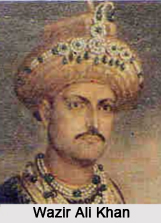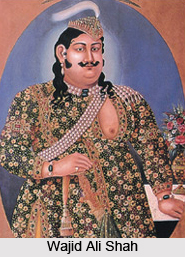 Awadh or Oudh, a region in present day Uttar Pradesh and Nepal`s Province 5 was established as one of the top-level imperial provinces under Mughal Emperor, Akbar. Saadat Ali Khan became the first Subadar Nawab of Awadh and was succeeded by various other Nawabs to lead the province. British rule in India (which covers the British East India Company rule from 1757 to1858) coincided with the rule of Nawab Shuja-ud-Daula in Awadh. Given below are the rulers of Awadh during British rule in India.
Awadh or Oudh, a region in present day Uttar Pradesh and Nepal`s Province 5 was established as one of the top-level imperial provinces under Mughal Emperor, Akbar. Saadat Ali Khan became the first Subadar Nawab of Awadh and was succeeded by various other Nawabs to lead the province. British rule in India (which covers the British East India Company rule from 1757 to1858) coincided with the rule of Nawab Shuja-ud-Daula in Awadh. Given below are the rulers of Awadh during British rule in India.
Shuja-Ud-Daula
Shuja Ud-Daula, the Nawab of Awadh was the son of Safgdar Jang and his successor to the throne of Awadh. His rule continued from 1754 to 1775. His rule was marked by interference by the British. He was controlled by them in relation to the maintenance of troops and the signing of treaties with other regional rulers. But the interference could not stop Shuja-Ud-Duala from properly administering Awadh. During his reign, the economy of the province flourished. Faizabad was beautified with stately buildings. Lucknow witnessed agrarian and commercial prosperity.
Asaf-Ud-Daula
Asaf- Ud-Daula, the Nawab of Awadh ruled from 1775 to 1797. His tenure was marked with the changes in Awadh politics. He moved the court of Awadh from Faizabad to Lucknow in 1775. Lucknow converted into an intellectual hub with the inflow of Shia emigrants from Iranian cities at the time. The Nawab had constructed a large palace garden complex as residence for himself called Daulat Khana. He is credited with the construction of major mosques like Asfi Masjid, enlargement of the Chowk and setting up of major markets with the aim to frame the core of the royal quarter of the city. The construction of the gateway, Rumi Darwaza and Bara Imambara was an attempt to provide assistance to the victims of famine of 1784.
Wazir Ali Khan
Wazir Ali Khan, the Nawab of Awadh ruled from 1797 to 1798. Wazir Ali"s accession was challenged by his uncle Sadat Ali, on grounds of his spurious birth, but Wazir Ali`s claim was accepted by the British. However, Sir John Shore`s constricting policies annoyed Wazir Ali. He was superseded by Sadat Ali Khan, who agreed to please the Governor General.
Saadat Ali Khan II
Saadat Ali Khan II, the Nawab of Awadh ruled from 1798 to 1814. At the time, Awadh got reduced to half its size and the British Resident became so powerful that he claimed the de-facto guardianship of wasiqadars or pensioners against the Nawab and also grabbed the right to hold a darbar or court. Saadat Ali Khan II is credited with the commissioning of many palaces like Dilkusha, Hayat Baksh Kothi, Farhat Baksh Kothi, Lal Baradari, etc.
Ghazi-Ud-Din Haider
Ghazi-Ud-Din Haider ruled as the Nawab of Awadh from 1814-1818 and as the first King of Awadh from 1818 to 1827. He discontinued the frayed ties between the defunct Mughal Empire and Awadh, declared it an independent state in 1819 and started ruling under the title of Badshah-i-Awadh or the King of Oudh. But the Resident continued to be more powerful than the King. Ghazi-Ud-Din Haider is credited with the construction of many monuments in Lucknow.
Nasir-Ud-Din Haider
Nasir-Ud-Din Haider, the King of Awadh ruled from 1827 to 1837. Being fond of women, the ruler lived mostly in women quarters and lavishly. At the time, Wazir Hakim Mahdi and later Raushan-ud-Daula were responsible for the administration of the state. Nasir-Ud-Din Haider did not have any offspring. When he died, Badshah Begum desired Munna Jan to occupy the throne, who was not accepted as a royal descendent by Ghazi-Ud-Din Haider and Nasir-Ud-Din Haider. The British took control of the situation, arresting Munna Jan and Badshah Begum and succeeded Nasir-Ud-Daula, the son of late Nawab Sadat Ali Khan to the throne. In exchange, Nasir-Ud-Daula promised to pay a large sum of money to the British.
Mohammad Ali Shah
Muhammad Ali Shah, the King of Awadh ruled from 1837 to 1842. He is credited with the construction of Husainabad (Chhota) Imambara in 1838 and an edifice similar to Babylon"s minaret or floating garden, which was named Satkhanda.
Amjad Ali Shah
Amjad Ali Shah, the King of Awadh ruled from 1842 to1847. His religious self kept him from becoming a capable ruler of Awadh and consequently the state"s administrative system became completely disorganized. His power was also suppressed by the opposing power of the British East India Company and its interference in the affairs of the kingdom.
Wajid Ali Shah
Wajid Ali Shah, the King of Awadh ruled from 1847 to 1856. At the time, the British East India Company was eyeing the throne of Awadh. The treaty of 1801 allowed the British to occupy much of the kingdom. Awadh was sucked dry by the imposition of a hugely expensive, British-run army and repeated demands for loans. The British East India Company strongly controlled the purse strings and majority of the officers in the army were British. Studies suggest that Awadh came under British rule well before the annexation, with the Nawab playing little more than a titular role.






































